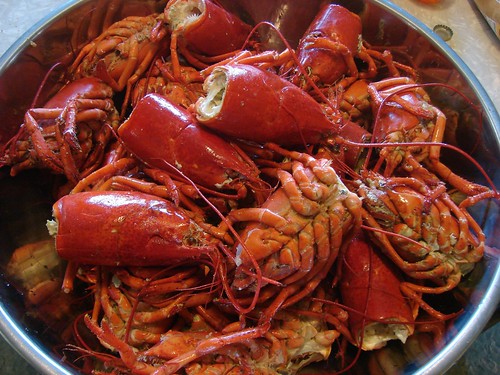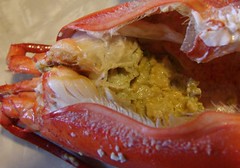 One of our regular stops when we head to Maine is the Bedrock Lobster Pound on US1 in York. It's an unassuming little buiding set back from the road, with the best lobster prices on the coast. When we're staying a few days, we'll drop in on the way back to the camper or the cabin and pick up a few bugs for supper. When we're on the way home, though, we go for something no less delicious, but a lot less elegant: Lobster bodies, aka "bugheads."
One of our regular stops when we head to Maine is the Bedrock Lobster Pound on US1 in York. It's an unassuming little buiding set back from the road, with the best lobster prices on the coast. When we're staying a few days, we'll drop in on the way back to the camper or the cabin and pick up a few bugs for supper. When we're on the way home, though, we go for something no less delicious, but a lot less elegant: Lobster bodies, aka "bugheads."Not all of a lobster's deliciousness is found in the claws and tail, and some lobster pounds that provide restaurants and roadside clamshacks with tails and claws for lobster rolls don't just throw the bodies to the seagulls. Bedrock, for example, bags lobster bodies in lots of twelve, which this week were selling for $2.00 a bag. We bought two bags and stuck them in the cooler to keep them fresh on the ride home.
 The next day, my wife Maryanne and I set to work picking our $4.00 bargain. We started by stripping off all of the little legs. The meat in the legs comes out easily if you break off each joint individually from the base to the tip. Once that was done we removed the carapace, or red shell segment, from each body.
The next day, my wife Maryanne and I set to work picking our $4.00 bargain. We started by stripping off all of the little legs. The meat in the legs comes out easily if you break off each joint individually from the base to the tip. Once that was done we removed the carapace, or red shell segment, from each body.  Inside the carapace, you'll find the creamy green liver, called the "tomalley." We scooped all the tomalley and all the jelly-like white fat from inside the bodies into a bowl along with any red coral (lobster roe) that we found. Tomalley is delicious all by itself spread on toast, but it can also be used to give lobster flavor to dips and spreads.
Inside the carapace, you'll find the creamy green liver, called the "tomalley." We scooped all the tomalley and all the jelly-like white fat from inside the bodies into a bowl along with any red coral (lobster roe) that we found. Tomalley is delicious all by itself spread on toast, but it can also be used to give lobster flavor to dips and spreads.As we emptied the shells, we broke them up into little pieces and put them in a stockpot to make lobster stock.
And that left us with a pile of shelled, legless bodies. This is the tedious part: Maryanne and I spent about an hour and a half breaking the bodies open down the middle and picking out the meat in the little "pockets" along the belly. In an average pound-and-a-half sized lobster, there are two large chunks of meat where the large arms meet the body, and eight smaller chunks - one in each of the pockets where the smaller legs meet the body. When all was said and done, we ended up with about five cups of picked meat, and about two cups of tomalley/body fat/roe.
 Recipes:
Recipes:Tomalley Croutons / Tomalley Butter
1 teaspoon garlic, finely minced
2 tablespoons onion, chopped
4 tablespoons butter, softened
1 tablespoon chopped parsley
1/2 cup lobster tomalley
salt, pepper, and paprika to taste
1 crusty French baguette
Sauté the garlic and onion in 1 tablespoon butter. Allow to cool, then mix with the remaining butter and parsley. Use a fork to blend in the tomalley, then season to taste with salt, pepper, and paprika.
Slice the baguette 3/8 inch thick and toast on both sides. Spread each slice with the tomalley-butter mixture. Place on a sheetpan and run under the broiler just until the croutons are crispy and hot; the tomalley butter will melt deliciously into the crouton. Serve hot and cris;y.
You can make a bigger batch of tomalley butter if you have more than the tomalleys from two lobsters; just scale the rest of the ingredients accordingly.
If you decide not to make tomalley croutons, try taking a big dab of the tomalley butter and spreading it to melt over a grilled steak. As surprising as this sounds, this tastes absolutely amazing.
Lobster Salad
Makes 2 servings
1 cup picked lobster meat
3 tablespoons finely chopped sweet onions
3 tablespoons finely chopped celery
1 tablespoon sweet pickle relish
Mayonnaise sufficient to moisten
salt and pepper to taste
Combine all ingredients and mix with a fork. Serve in sandwiches, or on crackers, or in the center of a scooped-out fresh tomato.

Lobster Stock
Makes 2 quarts
Lobster shells
1 large onion, chopped
2 celery stalks, chopped
1 large carrot, chopped
2 bay leaves
8 or 10 peppercorns
a handful of parsley
Water
Break the lobster shells into pieces and cram as many as you can into a 10-quart stockpot. Add onions, celery, carrots, bay leaves, peppercorns, and parsley then cover with water. Bring to a boil over high heat, then turn the fire down low and simmer for several hours. Strain stock through cheesecloth and refrigerate or freeze until needed.
To make a broth rather than a stock, return the stock to the pot after straining and simmer over medium heat until the stock has been reduced by half.
Season stock or broth to taste after simmering is finished to avoid concentrating the salt.

2 comments:
For really amazing, add a few drops of sherry to the tomalley.
When I cook lobster I use every last bit. I love the tamale and roe (when lucky enough to get it). I usually par boil the lobster (short cook of about 3-4 mins). Take off the tail and claws (save the green tamale and roe which looks like black you-know-what but once cooked turns red). Then split open the heads and sprinkly with seasonings of choice, some bread crumbs and then olive oil and roast them in the oven or on the grill. Then I eat up every last bit. Oh yeah dont forget to pull out their tiny little brain or dont eat it at least. Then every last remainder goes in a pot with aromatic veggies (e.g., carrots, celery, onion) and gets gently boiled for 20-30 mins. Drain and strain and use for the any seafood soup (mmmm.. Lobster Bisque) or freeze for later.
Post a Comment